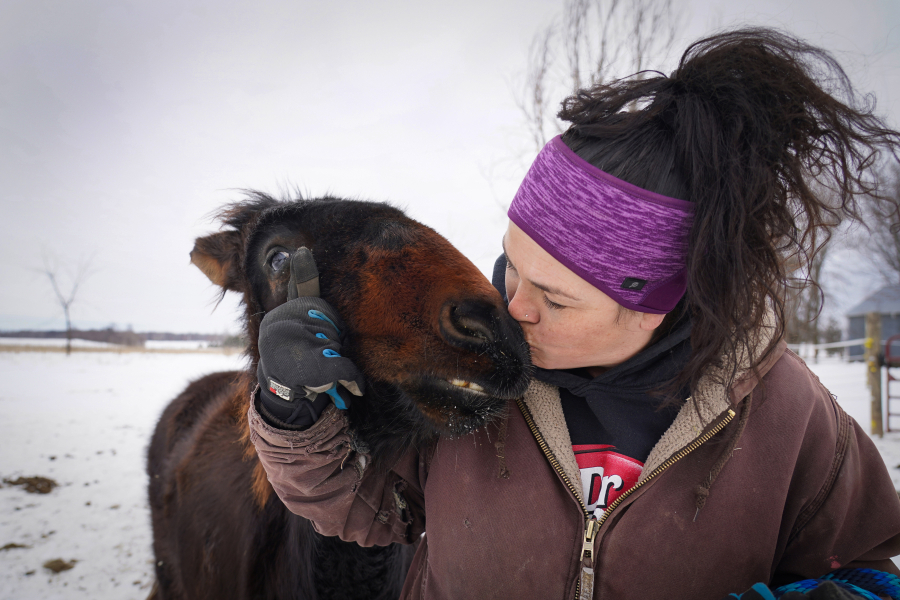From a distance, Kym Garvey’s farm in Milaca, Minn., looks like it hosts a herd of long-eared, shaggy-haired horses. But once you’re within patting distance, it’s easy to see the difference between Garvey’s 40 or so donkeys and their more skittish equine cousins. The donkeys approach in search of scratches, then nuzzle up to any receptive companion. Their eager bray sounds like a rhythmic honk, crossed with a howl and a wheeze.
“They really like to be with people,” said Garvey, who operates the nonprofit donkey rescue Save the Brays. “A group of horses will come over and see if you have treats and say hi, and then they’ll walk off,” she explained. “But a donkey will stand there with you all day long. The personality is kind of like a big dog.”
The reputations of the two equine species couldn’t be more different. Horses are often seen as status symbols associated with racing, riding or fox hunting. Meanwhile, donkeys are viewed as lowly laborers — Jesus rode a donkey into Jerusalem to signal his humility.
Garvey, who grew up with horses, switched her allegiance to donkeys after falling in love with the much-maligned species, which she bestows with affection and pet names (“goofy old boy” and “squeaky geeky” among them). As she rehabilitates and rehomes hundreds of long-eared equines, Garvey spreads her donkey allegiance to volunteers and adoptive families around the region, who say they find caring for the animals both fun and therapeutic.
Garvey hopes Save the Brays can raise awareness of a misunderstood species whose unique needs are often overlooked.
“Horses are such a prized possession,” she explained. “Donkeys are known as beasts of burden and they’re just kind of forgotten about. They’re the most abused animals in the world because in other countries they’re used so much for work.”
Growing popularity
Most of the world’s nearly 50 million donkeys are used for agricultural labor and as pack animals. But in the United States, they are mostly “a pet that you’re going to love on,” as Garvey puts it. Donkeys’ popularity here has been growing, due to their ability to provide companionship as well as drive carts, or carry people and supplies.
Donkeys are relatively easy to care for and don’t require as much feed as horses, Garvey noted. And there’s a lot of interest in saddling up the larger varieties. “It’s hard to find mammoth donkeys now because so many people want them for riding,” she explained.
Some people use donkeys as livestock guardians, but Garvey, a former large animal veterinary technician, cautions against simply putting them out with the sheep, goats, horses or cows without accounting for donkeys’ specific behaviors and needs. Other animals’ feed isn’t appropriate, she noted, and the donkeys’ playful nature can lead to their accidentally harming a smaller animal.
Donkeys’ temperaments are different from those of horses, Garvey added. Horses can be reactive to every bump in the trail, while donkeys offer a mellower ride. Their reputation for being stubborn is simply a result of their being more deliberate than flightier horses.
The need for rescue
After informally assisting donkeys for years and realizing there were no donkey-specific rescues in the area, Garvey made Save the Brays an official nonprofit in 2016. Lately, Garvey has had up to 60 animals in her care at one time (her herd typically includes a few mules, too, which are the offspring of a male donkey and female horse).
Save the Brays raises money by selling calendars and hosting fundraisers, and maintains an Amazon wish list for anyone wanting to gift everything from stable blankets to purple glitter hoof polish.
Because donkeys’ lifespan can reach 40 to 50 years, some arrive at Save the Brays due to outliving their owners’ capacity to care for them, or owners’ financial stress. Other donkeys come to Garvey through the Minnesota Hooved Animal Rescue Foundation, which receives animals seized by law enforcement, often due to being undernourished, or lacking health care or safe, sanitary shelter.
Because MHARF focuses on horses, its executive director, Drew Fitzpatrick, has appreciated being able to send donkeys to Garvey. “I can trust her,” Fitzpatrick said. “She knows what she’s doing.”
Fitzpatrick sees parallels between the poor treatment of equines needing rescue and elderly people in America.
“To see anything be taken advantage of and spurned and turned away and treated like an afterthought,” she said. “The older I get, I realize that it happens to all of us.”
Garvey has purchased donkeys at livestock auctions, to save those at risk of being killed for their hides. Gelatin produced from donkey skins is used in a popular Chinese medicine, and its demand has led to theft, poaching and inhumane treatment of donkeys worldwide.
Some animals arrive at Save the Brays with health problems so substantial they need to be euthanized — the part of the work Garvey finds most difficult.
The rest typically stay about five months, though a few special-needs animals live out their days at the farm.




